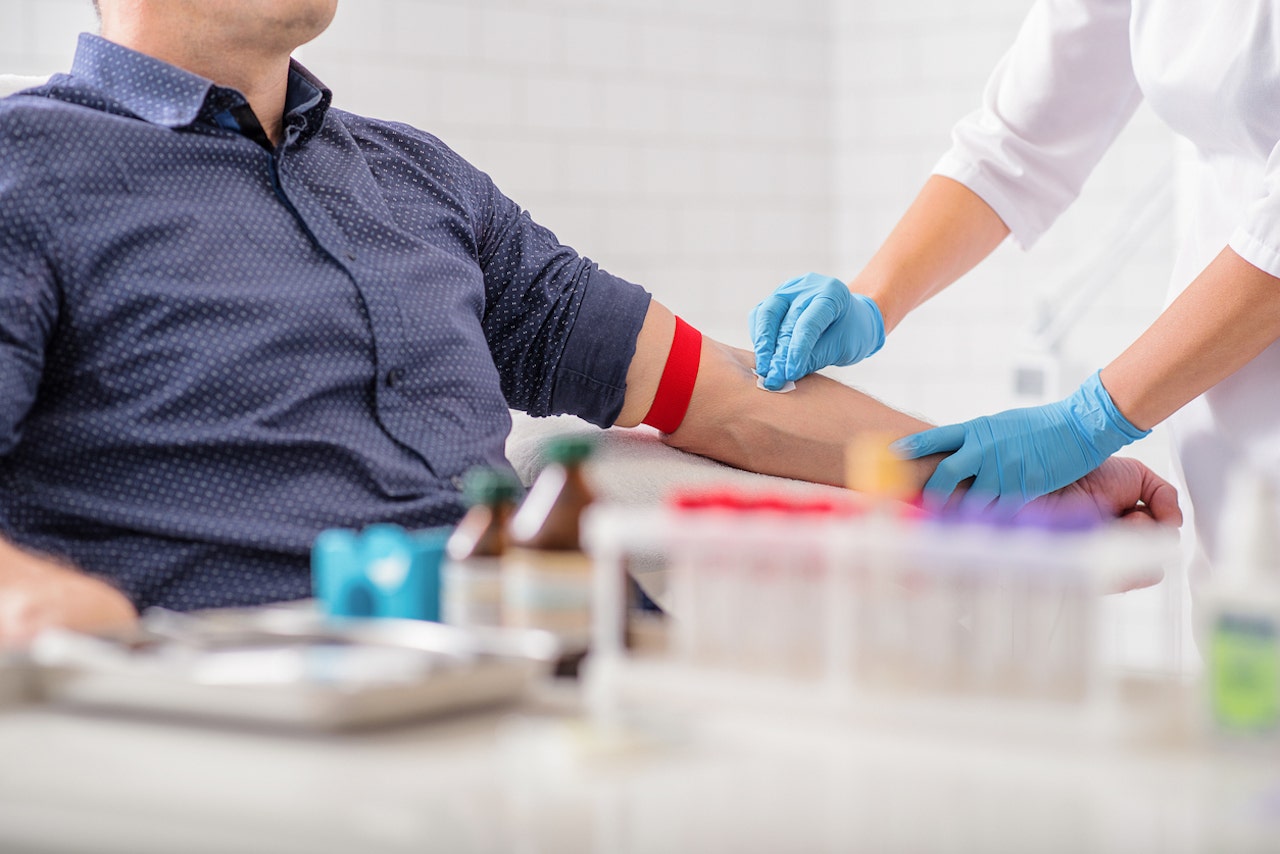Health
AI blood test could detect Parkinson's disease up to 7 years before symptoms: 'Particularly promising'

A new blood test could reveal Parkinson’s diagnoses up to seven years before symptoms emerge.
Researchers from University College London and University Medical Center Goettingen in Germany used artificial intelligence to develop the test.
The study, which was published in the journal Nature Communications, included 72 patients with rapid eye movement behavior disorder (iRBD), a condition that has been linked to a higher risk of Alzheimer’s.
WHAT IS ARTIFICIAL INTELLIGENCE?
When the researchers used machine learning to analyze blood samples from the patients, they discovered that 79% of them had the same biomarkers as people with Parkinson’s.
A new blood test could reveal Parkinson’s diagnoses up to seven years before symptoms emerge, according to recent research. (iStock)
Over a 10-year follow-up period, the researchers confirmed that 16 of the patients went on to develop Parkinson’s, a movement disorder that affects nearly one million people in the U.S.
“By determining eight proteins in the blood, we can identify potential Parkinson’s patients several years in advance,” said co-first-author Dr. Michael Bartl from the University Medical Center Goettingen in a press release.
MILITARY VETERAN EMBRACES ‘NEW SERVICE’ OF HELPING OTHERS AFTER HIS PARKINSON’S DIAGNOSIS: ‘THERE IS HOPE’
“This means that drug therapies could potentially be given at an earlier stage, which could possibly slow down disease progression or even prevent it from occurring.”
“We have not only developed a test, but can diagnose the disease based on markers that are directly linked to processes such as inflammation and degradation of non-functional proteins. So these markers represent possible targets for new drug treatments.”

When the researchers used machine learning to analyze blood samples from the patients, they discovered that 79% of them had the same biomarkers as people with Parkinson’s. (iStock)
Blood tests provide a less invasive alternative to a lumbar puncture (also known as a spinal tap), which has been used more often to diagnose Parkinson’s in clinical research, according to professor David Dexter, director of research at Parkinson’s UK.
“This research, co-funded by Parkinson’s UK, represents a major step forward in the search for a definitive and patient friendly diagnostic test for Parkinson’s,” Dexter said in the release.
RESEARCHERS FIND SOURCES OF FOUR BRAIN DISORDERS, WHICH COULD LEAD TO NEW TREATMENTS
Looking ahead, the researchers plan to follow the participants to confirm the accuracy of the test, and will also analyze samples from others in the population who have a genetic mutation that puts them at a higher risk of developing Parkinson’s.
“The findings add to an exciting flurry of recent activity toward finding a simple way to test for and measure Parkinson’s.”
“With more work, it may be possible that this blood-based test could distinguish between Parkinson’s and other conditions that have some early similarities, such as multiple systems atrophy or Lewy body dementia,” Dexter said in the release.
“The findings add to an exciting flurry of recent activity toward finding a simple way to test for and measure Parkinson’s.”

Dr. Harvey Castro, a Dallas, Texas-based board-certified emergency medicine physician and national speaker on AI in health care, said the blood test could serve as a model for other diseases. (Dr. Harvey Castro)
Dr. Harvey Castro, a Dallas, Texas-based board-certified emergency medicine physician and national speaker on AI in health care, was not involved in the blood test but spoke to Fox News Digital about its potential impact.
For more Health articles, visit www.foxnews/health.
“As an ER physician deeply involved in AI applications in health care, I find this development particularly promising,” Castro said.
“It exemplifies the potential of AI to diagnose and predict serious health conditions, allowing for earlier and potentially more effective interventions.”

Nearly one million people in the U.S. are living with Parkinson’s disease, according to the Parkinson’s Foundation. (iStock)
This approach could serve as a model for other diseases, Castro suggested.
“Having a tool that provides more time before significant nerve cell damage occurs offers a substantial opportunity to address diseases at very early stages, where traditional diagnostic methods might not detect them,” the doctor said.
CLICK HERE TO SIGN UP FOR OUR HEALTH NEWSLETTER
“This early intervention capability could significantly slow the disease progression.”
Although knowing about a disease in advance can help patients prepare mentally and emotionally, Castro warned that it could be a “double-edged sword.”

“Having a tool that provides more time before significant nerve cell damage occurs offers a substantial opportunity to address diseases at very early stages,” one doctor said. (iStock)
“While some patients may benefit from early knowledge and the ability to plan their lives accordingly, others might prefer not to know about a potential future illness due to the psychological burden it could impose,” he said.
Overall, Castro said, this AI-powered blood test represents a “paradigm shift” in the approach to neurodegenerative diseases like Parkinson’s.
“It underscores the importance of integrating advanced technologies into medical practice to enhance patient outcomes and transform health care delivery,” he said.
Fox News Digital reached out to the study researchers for additional comment.

Health
How The Great British Bake Off Host Alison Hammond Lost 150 Lbs Naturally

Sign Up
Create a free account to access exclusive content, play games, solve puzzles, test your pop-culture knowledge and receive special offers.
Already have an account? Login
Use left and right arrow keys to navigate between menu items.
Use escape to exit the menu.
Health
One state leads country in human bird flu with nearly 40 confirmed cases

A child in California is presumed to have H5N1 bird flu, according to the San Francisco Department of Public Health (SFDPH).
As of Dec. 23, there had been 36 confirmed human cases of bird flu in the state, according to the California Department of Public Health (CDPH).
This represents more than half of the human cases in the country.
LOUISIANA REPORTS FIRST BIRD FLU-RELATED HUMAN DEATH IN US
The latest pediatric patient, who lives in San Francisco, experienced fever and conjunctivitis (pink eye) as a result of the infection.
The unnamed patient was not hospitalized and has fully recovered, according to the SFDPH.
A child in California is presumed to have H5N1 bird flu, according to the San Francisco Department of Public Health. (iStock)
The child tested positive for bird flu at the SFDPH Public Health Laboratory. The U.S. Centers for Disease Control and Prevention (CDC) will perform additional tests to confirm the result.
CLICK HERE TO SIGN UP FOR OUR HEALTH NEWSLETTER
It is not yet known how the child was exposed to the virus and an investigation is ongoing.
“I want to assure everyone in our city that the risk to the general public is low, and there is no current evidence that the virus can be transmitted between people,” said Dr. Grant Colfax, director of health, in the press release.
BIRD FLU PATIENT HAD VIRUS MUTATIONS, SPARKING CONCERN ABOUT HUMAN SPREAD
“We will continue to investigate this presumptive case, and I am urging all San Franciscans to avoid direct contact with sick or dead birds, especially wild birds and poultry. Also, please avoid unpasteurized dairy products.”
Samuel Scarpino, director of AI and life sciences and professor of health sciences at Northeastern University in Boston, is calling for “decisive action” to protect individuals who may be in contact with infected livestock and also to alert the public about the risks associated with wild birds and infected backyard flocks.

An infectious diseases expert called for “decisive action” to alert the public about the risks associated with wild birds and infected backyard flocks. (iStock)
“While I agree that the risk to the broader public remains low, we continue to see signs of escalating risk associated with this outbreak,” he told Fox News Digital.
Experts have warned that the possibility of mutations in the virus could enable person-to-person transmission.
“While the H5N1 virus is currently thought to only transmit from animals to humans, multiple mutations that can enhance human-to-human transmission have been observed in the severely sick American,” Dr. Jacob Glanville, CEO of Centivax, a San Francisco biotechnology company, told Fox News Digital.

As of Jan. 10, there have been a total of 707 infected cattle in California, per reports from the California Department of Food and Agriculture. (iStock)
“This highlights the requirement for vigilance and preparation in the event that additional mutations create a human-transmissible pandemic strain.”
As of Jan. 10, there have been a total of 707 infected cattle in California, per reports from the California Department of Food and Agriculture (CDFA).
For more Health articles, visit www.foxnews.com/health
In the last 30 days alone, the virus has been confirmed in 84 dairy farms in the state.
Health
Chronic Pain Afflicts Billions of People. It’s Time for a Revolution.

“In the beginning, everyone thought they were going to find this one breakthrough pain drug that would replace opioids,” Gereau said. Increasingly, though, it’s looking like chronic pain, like cancer, could end up having a range of genetic and cellular drivers that vary both by condition and by the particular makeup of the person experiencing it. “What we’re learning is that pain is not just one thing,” Gereau added. “It’s a thousand different things, all called ‘pain.’”
For patients, too, the landscape of chronic pain is wildly varied. Some people endure a miserable year of low-back pain, only to have it vanish for no clear reason. Others aren’t so lucky. A friend of a friend spent five years with extreme pain in his arm and face after roughhousing with his son. He had to stop working, couldn’t drive, couldn’t even ride in a car without a neck brace. His doctors prescribed endless medications: the maximum dose of gabapentin, plus duloxetine and others. At one point, he admitted himself to a psychiatric ward, because his pain was so bad that he’d become suicidal. There, he met other people who also became suicidal after years of living with terrible pain day in and day out.
The thing that makes chronic pain so awful is that it’s chronic: a grinding distress that never ends. For those with extreme pain, that’s easy to understand. But even less severe cases can be miserable. A pain rating of 3 or 4 out of 10 sounds mild, but having it almost all the time is grueling — and limiting. Unlike a broken arm, which gets better, or tendinitis, which hurts mostly in response to overuse, chronic pain makes your whole world shrink. It’s harder to work, and to exercise, and even to do the many smaller things that make life rewarding and rich.
It’s also lonely. When my arms first went crazy, I could barely function. But even after the worst had passed, I saw friends rarely; I still couldn’t drive more than a few minutes, or sit comfortably in a chair, and I felt guilty inviting people over when there wasn’t anything to do. As Christin Veasley, director and co-founder of the Chronic Pain Research Alliance, puts it: “With acute pain, medications, if you take them, they get you over a hump, and you go on your way. What people don’t realize is that when you have chronic pain, even if you’re also taking meds, you rarely feel like you were before. At best, they can reduce your pain, but usually don’t eliminate it.”
A cruel Catch-22 around chronic pain is that it often leads to anxiety and depression, both of which can make pain worse. That’s partly because focusing on a thing can reinforce it, but also because emotional states have physical effects. Both anxiety and depression are known to increase inflammation, which can also worsen pain. As a result, pain management often includes cognitive behavioral therapy, meditation practice or other coping skills. But while those tools are vital, it’s notoriously hard to reprogram our reactions. Our minds and bodies have evolved both to anticipate pain and to remember it, making it hard not to worry. And because chronic pain is so uncomfortable and isolating, it’s also depressing.
-

 Politics1 week ago
Politics1 week agoCarter's judicial picks reshaped the federal bench across the country
-

 Politics1 week ago
Politics1 week agoWho Are the Recipients of the Presidential Medal of Freedom?
-

 Health1 week ago
Health1 week agoOzempic ‘microdosing’ is the new weight-loss trend: Should you try it?
-

 World1 week ago
World1 week agoSouth Korea extends Boeing 737-800 inspections as Jeju Air wreckage lifted
-
/cdn.vox-cdn.com/uploads/chorus_asset/file/25822586/STK169_ZUCKERBERG_MAGA_STKS491_CVIRGINIA_A.jpg)
/cdn.vox-cdn.com/uploads/chorus_asset/file/25822586/STK169_ZUCKERBERG_MAGA_STKS491_CVIRGINIA_A.jpg) Technology4 days ago
Technology4 days agoMeta is highlighting a splintering global approach to online speech
-

 News1 week ago
News1 week agoSeeking to heal the country, Jimmy Carter pardoned men who evaded the Vietnam War draft
-

 News1 week ago
News1 week agoTrump Has Reeled in More Than $200 Million Since Election Day
-

 News1 week ago
News1 week agoThe U.S. Surgeon General wants cancer warnings on alcohol. Here's why















